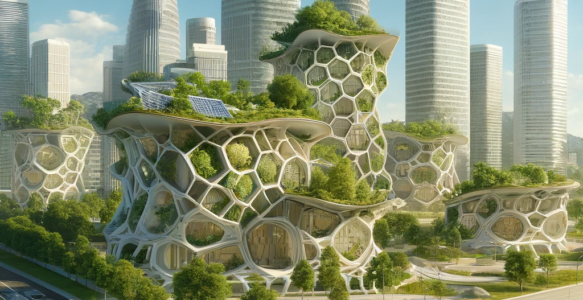
The field of biomimicry in architecture shows how working together across different disciplines can lead to innovation and more sustainable building designs. By combining knowledge from architecture and biology, we can create buildings that are efficient, sustainable, and work in harmony with the environment.
In architecture, drawing inspiration from nature involves architects and biologists working together closely. Their shared knowledge about biology and ecosystems is key to making biomimicry work. This method uses ideas from nature to create building solutions that save energy and integrate well with the environment.
Biology gives architects a wealth of strategies for making buildings better adapted, more resilient, and energy efficient. By looking at how organisms and ecosystem’s function, architects can imitate these natural processes. For instance, the Eastgate Centre in Harare, Zimbabwe, uses designs inspired by termite mounds to keep the building cool naturally, which cuts down on energy use significantly.
Working with biologists helps architects gain a deeper understanding of materials, building structure, and resilience. Biologists provide insights into how nature achieves its forms and functions, which can lead to new ideas for building designs.
- Structural Innovation: Biologists show architects how nature designs structures to withstand environmental stress, leading to smarter and more efficient building designs.
- Material Science: By studying materials like spider silk or the structure of bird bones, architects can find new, strong, yet lightweight materials for building.
- Energy Efficiency: Looking at how plants do photosynthesis and how animals regulate their body heat can inspire ways to design buildings that use less energy and rely on renewable sources.

Reference: The next big technological leap is biological – Wood Magazine (swedishwood.com)
While there are many benefits, communication between architects and biologists can be challenging. They often use different terms and have different goals, which can cause misunderstandings and slow down projects. Regular workshops, shared projects, and training programs in biomimicry can help bridge these gaps and ensure everyone is on the same page.
Many successful projects show the benefits of architects and biologists working together. The Biomimicry Institute has shared many examples where collaborative efforts have led to buildings that are thoughtful, responsible, and innovative. These cases show how biomimicry can be applied in real-world projects and point to exciting possibilities for future work.
The partnership between architecture and biology in biomimicry shows the power of teamwork across fields. By using principles from biology in building design, we can create structures that are not only eye-catching and innovative but also fit well with their natural surroundings. This approach helps advance architectural practices and contributes to a sustainable future, showing how vital it is to incorporate biological principles in design.

